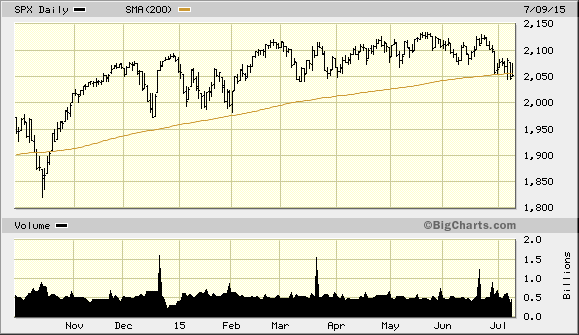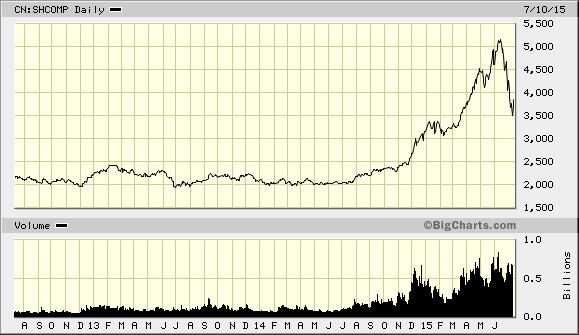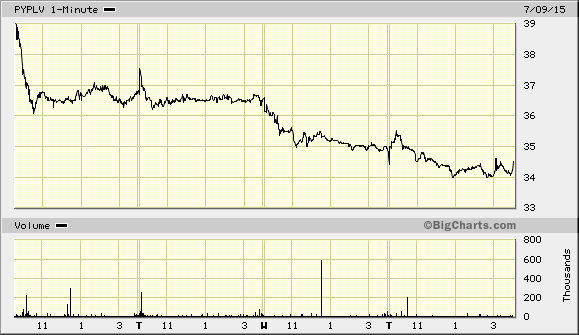CWS Market Review – July 10, 2015
“Greece doesn’t need to borrow money only to pay off its past debts,
it has to borrow just to keep the lights on.” – James Surowiecki
What a crazy week! First we had a massive “no” vote in Greece. All the banks there have been shut down, and cash is running out. The officials there are working on a last-minute deal to keep Greece in the eurozone. But the bigger story is in China where a massive stock bubble has started to deflate. In the last three weeks, the Chinese market has shed $3 trillion in value.
To top it off, a technical glitch at the NYSE halted all trading for several hours on Wednesday. That was enough to send the S&P 500 to its lowest close since March 11. For the first time since October, the S&P 500 closed below its 200-day moving average. Except for six days in October, the index has traded above its 200-DMA since November 2012.
The good news for us is that this hasn’t had much impact on our Buy List. There are enough exchanges to reroute orders through, so our stocks weren’t affected. Also, we’re not heavily exposed to Greece or China. Our stocks are very high-quality which serves as a buffer during rough patches.
Get ready, because earnings season kicks off for us next week as Wells Fargo is due to report on Tuesday, July 14. We also have the eBay/PayPal spinoff coming up soon. But first, let’s look at the latest news out of Greece, which is promising.
Finally, Some Optimism for Greece
On Sunday, voters in Greece rejected the latest bailout terms from the troika—that’s the EU, ECB and IMF. Once the results were announced, there was literally dancing in the streets of Athens.
So what does the vote mean? That’s hard to say. The Greek Prime Minister, Alexis Tsipras, says that it gives him more negotiating power; however, the troika isn’t terribly interested in more negotiations. They told Tsipras he has until the end of the week to present a new proposal.
If they can’t reach a deal, this could mean that Greece will ditch the euro. All sides agree they don’t want that to happen. On Tuesday, the EU held a meeting and decided to hold another meeting this Sunday to decide what to do with Greece.
All the banks in Greece are shut down, and cash is hard to come by. Customers are allowed to withdraw only 60 euros a day. The banks are going to be closed for a few more days, and it’s not clear if they have enough cash to survive. That’s how bad it is. The EU wants to impose even more austerity on Greece, which is highly unpopular.
Bear in mind that Greece’s economy is doing worse now than the U.S. economy did during the Great Depression. It’s clear that a lot of politicians in Europe are simply fed up with Greece. James Surowiecki of The New Yorker said, “Greece doesn’t need to borrow money only to pay off its past debts, it has to borrow just to keep the lights on.” It’s sad to see such a beautiful country in such a difficult position.
As I said last week, there’s not much to fear from financial contagion if Greece leaves the euro. That’s what was so feared in 2012, when Mario Draghi made his famous speech (“Within our mandate, the ECB is ready to do whatever it takes to preserve the euro. And believe me, it will be enough”). Now the fear isn’t financial contagion but political contagion. If the Greeks can leave the euro, perhaps Portugal or Italy will be right behind. I think it’s way too soon to be concerned with that.
Late Thursday, the Greek government submitted its latest plan. From Business Insider:
Greece’s proposal on Thursday includes debt restructuring, a 35 billion-euro growth package, a proposed primary budget surplus equal to 1% of GDP in 2015, followed by surpluses of 2%, 3% and 3.5% from 2016-2018.
This plan also has the same value-added-tax reform effective as of July 1, which targets a net revenue gain of 1% of GDP. This plan also proposes an increase on corporate taxes to a rate of 28% from 26%.
Now the hard work begins. The plan needs to pass the Greek parliament and then get the seal of approval from the EU. Some pressure is building on the Germans to take the deal. It’s early, but the markets seem optimistic. I haven’t parsed the new proposal but it seems very similar to the deal that voters rejected. Frankly, this was a whole lot of drama for very little.
Communist China Deals with a Stock Bubble
As much attention as Greece has received, the numbers involved there are minuscule compared with the massive losses as China’s stock bubble has deflated. In the last three weeks, $3 trillion has evaporated. That’s 15 Greeces!
Two weeks ago, I told you to stay away from China, and the selling has only worsened since then. The government has no one to blame but themselves. Of course, they’re busy blaming their problems on “hostile foreign forces.” First, the Communist Party pushed people into the market. Then, the government tried to pop the bubble. Now they’re doing everything they can to support the bubble, and it’s not working. That’s the thing about free markets: you can’t control them.
China now has 90 million investors. That’s more than the Communist Party, and I’m sure there’s a lot of overlap. Some investors in China were borrowing at 22% to buy stocks. Most of these new investors don’t have a high-school education. To arrest the decline, the exchanges have suspended trading in hundreds of stocks. I guess that’s one way to stop a fall: prevent people from selling. But the Chinese market is still wildly inflated (see the Shanghai Composite below). Even after the plunge in prices, the median P/E Ratio for stocks is 53. That’s down from 108 at the peak. Valuations are still roughly triple the U.S. market.
When people can’t sell what they want, they sell what they can. Copper, for example, plunged 8.4% in two days to hit a six-year low. Oil dropped nearly 8% on Monday. In turn, that’s hurt many materials stocks. ExxonMobil (XOM) recently hit a new 52-week low. To be an investor is to understand how all these markets are connected. To quote Lester Freamon from The Wire, “all the pieces matter.”
It’s interesting to see that China is experiencing what we experienced in 1920s as margin borrowing drove stock prices higher. The opposite effect, deleveraging, can drive prices lower. Lower prices created margin calls. To cover your margin, you need to put up more money or sell. More selling leads to still lower prices, which creates still more margin calls.
I’m afraid that some of the problem is that too many investors in China are unfamiliar with the dynamics of a stock-market bubble. More investors in the West have learned that painful lesson. Ironically, a stock-market bust could lead to opposition to Communist rule.
Much of the time, I tell investors that this week’s “worry of the century” is vastly overrated. Ignore it, and focus on the long term. But the market rout in China is a serious problem. I can’t say how serious just yet, but I expect to see more losses in the Chinese markets. I also think we’ll see more pressure on commodity prices, which could be good for consumers.
In the longer term, China will have to rethink its strategy of being an export-driven economy. They have too many ghost cities and empty stadiums. The country needs domestic demand. There’s a lot of corruption built into the system, and I don’t see how that’s sustainable.
Fortunately, our Buy List has largely sidestepped the drama in Greece and China. But earnings season has begun, and we’ll soon see how well our stocks did during the second quarter. Now let’s take a look at our first stock to report.
Wells Fargo Is a Buy up to $57 per Share
Wells Fargo (WFC) continues to be one of my favorite stocks. The big bank is due to report Q2 earnings on Tuesday, July 14. The problem is that this is a tough environment for banks, especially mortgages. Last quarter, WFC’s lending margin fell below 3% for the first time in 20 years. Some of the major banks have seen weakness in their bond business. A lot of investors will be curious to see how bad the damage is.
Wall Street currently expects Wells to report Q2 earnings of $1.03 per share. That’s okay, but not great. This isn’t due to problems at Wells but to larger issues out of their control. I still like Wells for the long term. It’s the best-run large bank in the country.
Get Ready for PayPal’s Stock
eBay (EBAY) is due to report its Q2 earnings before the market opens on Thursday. Wall Street currently expects earnings of 72 cents per share, which is a modest increase from the 69 cents per share eBay netted in last year’s Q2. The online auction house said they expect Q2 earnings to range between 71 and 73 cents per share. My numbers say that’s a bit too low. I expect earnings of 75 cents per share, give or take. The company has been doing quite well lately.
But the big news will be the PayPal spinoff. Shares of PayPal (PYPL) will be distributed to eBay owners next Friday, July 17, and they’ll start trading on Monday, July 20. For each share you own of eBay, you’ll get one share of PayPal.
Although the PayPal shares haven’t started trading yet, the “when-issued” shares have (see above). Those shares should give you a rough idea of where the stock will be. The when-issued shares for PayPal closed Thursday at $34.50. The when-issued shares for eBay closed at $27.33. Next week, I’ll give you Buy Below prices for the new shares.
Microsoft Announces Big Layoffs
Last year, Microsoft (MSFT) bought Nokia’s phone business for $9.5 billion. I wasn’t thrilled about the idea, and other tech folks I follow were even less enthusiastic. This was one of Ballmer’s ideas, and he had a rash of unwise acquisitions.
This week, Microsoft basically washed their hands of the Nokia deal. Unfortunately, that involves laying off 7,800 workers. The deal wasn’t CEO Satya Nadella’s idea, but he’s left to clean up the mess. Microsoft will take a $7.6 billion accounting charge.
Nadella has been following a strategy of pulling back from areas that Ballmer got into. That’s the smart call. They recently sold their online display-ad business to AOL. This is a tough decision, but it reaffirms my faith in Nadella. He’s a strong leader, and he’s willing to turn the ship around.
MSFT gapped up in April after its earnings report, but it has slowly slid back ever since. I’m not expecting much for the upcoming earnings report, but MSFT looks good for the long term. If you can pick up MSFT below $45, you got a very good deal.
Buy List Updates
One of our stocks that’s been hit by the deflating bubble in China is Qualcomm (QCOM). On Tuesday, Qualcomm dropped to a two-year low of $61.48. The stock is a mess at the moment, and Wall Street is against them as well. Don’t lose faith just yet. QCOM still supports a 3.1% dividend.
One thing Qualcomm should do is spin off their chip business from their patent-licensing biz. Unfortunately, the company seems dead set against that idea. Of course, eBay said the same about spinning off PayPal. It’s funny how a plunging price can change minds. For now, I’m lowering Qualcomm’s Buy Below to $66 per share.
I’ve been beating the drum for Ford Motor (F), and the stock has continued to disappoint. The shares closed Thursday at $14.33, which is the lowest all year. The automaker announced another recall. They’re recalling 432,000 Focus, C-Max and Escape vehicles due to a software problem. Last week, Ford recalled 203,500 Transit Connect vans and Escape SUVs due to problems with the instrument panels and seatbelts. It’s like a broken record, but at least no one was hurt in this latest recall. Yes, I’m still a Ford bull, but I have to remind myself that this takes patience. Ford is now going for 7.6 times next year’s earnings.
That’s all for now. Expect more news from Greece next week and hopefully some resolution. We’re also going to get more earnings reports soon. On Tuesday, the Census Bureau will report the latest on retail sales. Industrial production and the Fed’s Beige Book are on Wednesday. Be sure to keep checking the blog for daily updates. I’ll have more market analysis for you in the next issue of CWS Market Review!
– Eddy
Posted by Eddy Elfenbein on July 10th, 2015 at 7:08 am
The information in this blog post represents my own opinions and does not contain a recommendation for any particular security or investment. I or my affiliates may hold positions or other interests in securities mentioned in the Blog, please see my Disclaimer page for my full disclaimer.
-
-
Archives
- April 2025
- March 2025
- February 2025
- January 2025
- December 2024
- November 2024
- October 2024
- September 2024
- August 2024
- July 2024
- June 2024
- May 2024
- April 2024
- March 2024
- February 2024
- January 2024
- December 2023
- November 2023
- October 2023
- September 2023
- August 2023
- July 2023
- June 2023
- May 2023
- April 2023
- March 2023
- February 2023
- January 2023
- December 2022
- November 2022
- October 2022
- September 2022
- August 2022
- July 2022
- June 2022
- May 2022
- April 2022
- March 2022
- February 2022
- January 2022
- December 2021
- November 2021
- October 2021
- September 2021
- August 2021
- July 2021
- June 2021
- May 2021
- April 2021
- March 2021
- February 2021
- January 2021
- December 2020
- November 2020
- October 2020
- September 2020
- August 2020
- July 2020
- June 2020
- May 2020
- April 2020
- March 2020
- February 2020
- January 2020
- December 2019
- November 2019
- October 2019
- September 2019
- August 2019
- July 2019
- June 2019
- May 2019
- April 2019
- March 2019
- February 2019
- January 2019
- December 2018
- November 2018
- October 2018
- September 2018
- August 2018
- July 2018
- June 2018
- May 2018
- April 2018
- March 2018
- February 2018
- January 2018
- December 2017
- November 2017
- October 2017
- September 2017
- August 2017
- July 2017
- June 2017
- May 2017
- April 2017
- March 2017
- February 2017
- January 2017
- December 2016
- November 2016
- October 2016
- September 2016
- August 2016
- July 2016
- June 2016
- May 2016
- April 2016
- March 2016
- February 2016
- January 2016
- December 2015
- November 2015
- October 2015
- September 2015
- August 2015
- July 2015
- June 2015
- May 2015
- April 2015
- March 2015
- February 2015
- January 2015
- December 2014
- November 2014
- October 2014
- September 2014
- August 2014
- July 2014
- June 2014
- May 2014
- April 2014
- March 2014
- February 2014
- January 2014
- December 2013
- November 2013
- October 2013
- September 2013
- August 2013
- July 2013
- June 2013
- May 2013
- April 2013
- March 2013
- February 2013
- January 2013
- December 2012
- November 2012
- October 2012
- September 2012
- August 2012
- July 2012
- June 2012
- May 2012
- April 2012
- March 2012
- February 2012
- January 2012
- December 2011
- November 2011
- October 2011
- September 2011
- August 2011
- July 2011
- June 2011
- May 2011
- April 2011
- March 2011
- February 2011
- January 2011
- December 2010
- November 2010
- October 2010
- September 2010
- August 2010
- July 2010
- June 2010
- May 2010
- April 2010
- March 2010
- February 2010
- January 2010
- December 2009
- November 2009
- October 2009
- September 2009
- August 2009
- July 2009
- June 2009
- May 2009
- April 2009
- March 2009
- February 2009
- January 2009
- December 2008
- November 2008
- October 2008
- September 2008
- August 2008
- July 2008
- June 2008
- May 2008
- April 2008
- March 2008
- February 2008
- January 2008
- December 2007
- November 2007
- October 2007
- September 2007
- August 2007
- July 2007
- June 2007
- May 2007
- April 2007
- March 2007
- February 2007
- January 2007
- December 2006
- November 2006
- October 2006
- September 2006
- August 2006
- July 2006
- June 2006
- May 2006
- April 2006
- March 2006
- February 2006
- January 2006
- December 2005
- November 2005
- October 2005
- September 2005
- August 2005
- July 2005



 Eddy Elfenbein is a Washington, DC-based speaker, portfolio manager and editor of the blog Crossing Wall Street. His
Eddy Elfenbein is a Washington, DC-based speaker, portfolio manager and editor of the blog Crossing Wall Street. His